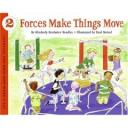
Forces Make Things Move by Kimberly Brubaker Bradley and Illustrated by Paul Meisel takes a concept that can be difficult to understand and explains it on a child’s level. The pushing and stopping of a toy car is used to explain force. Bradley explains that it takes a lot of force to move heavy objects such as a real car or a couch and just a little bit of force to move objects such as a leaves or papers that don’t weigh very much.
She then explains friction and gravity, two types of forces. She relates both of these forces again to the toy car. There is a really cute page that shows us what Earth would be like without gravity. The spilled milk fell to the ceiling rather than the floor. The cat is on the ceiling licking the spilled milk. Food, utensils and even the pet dog are floating around in the kitchen. There is even an experiment at the end of the book to find out more about friction.
Curriculum Connections
Although the book is suggested for 1st – 3rd grade, force seems to be a difficult concept to understand. This book would be a great introduction to force at the 4th grade level by helping to explain the characteristics and interaction of moving objects including changes in motion relating to force and mass and that friction is a force that opposes motion (VA SOL 4.2 b,c). The teacher could begin by reading to book to the class and then conducting the experiment at the back of the book to reinforce what they have learned about friction. The book could then kept in the classroom library as a fun reference.
Additional Resources
- Battleship online game: Sink your opponent’s ship by answering questions correctly. A review of essential knowledge relating to the fourth grade science unit on “Force, Motion and Energy.”
- A hands on lesson plan: May the Force be With You will help students understand that the greater the mass of an object, the greater the force needed to change its motion.
- Try this friction experiment: it uses a shoe, a rubber band and a ruler as well as some different items to create friction, such as aluminum foil, sand paper and cooking oil.
Book: Forces Make Things Move
Author: Kimberly Brubaker Bradley
Illustrator: Paul Meisel
Publisher: Harper Collins
Publication Date: 2005
Pages: 33 pages
Grade Range: 1-4
ISBN: 9780060289072
